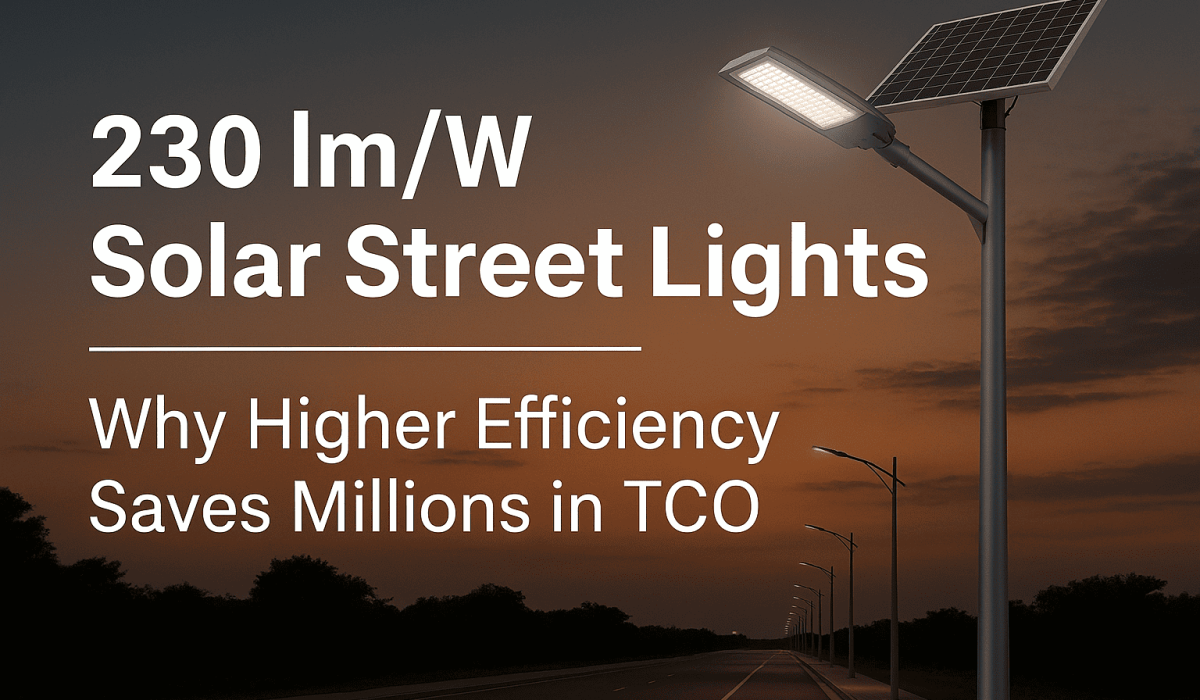When I first started managing solar street lighting projects across Africa and the Middle East, one of the most common client questions was simple: “How bright is your light?” At the time, many suppliers threw around inflated wattage numbers—200W, 300W, even 500W. But in real projects, those numbers meant very little. What truly matters is luminous efficacy, measured in lumens per watt (lm/W).
Today, with 230 lm/W solar street lights, we have reached a new benchmark. This isn’t just about brightness—it’s about delivering more light, longer lifespan, and lower total cost of ownership (TCO). For municipalities, EPC contractors, and industrial parks, choosing higher efficiency directly translates to millions in long-term savings.
Why Does 230 lm/W Matter in Solar Street Lights?
Answer in brief: A 230 lm/W solar street light produces significantly more light output with less power consumption, allowing for smaller solar panels, smaller batteries, and lower lifetime costs without sacrificing illumination standards.
For context:
- Old-generation LEDs delivered ~140–160 lm/W.
- Good modern LEDs now reach ~200 lm/W.
- Top-tier systems like Sunlurio’s 230 lm/W range push efficiency to the maximum practical level.
👉 This means a 60W solar street light today can deliver the same brightness that used to require 100–120W just five years ago.
How Do Higher lm/W Solar Street Lights Reduce CAPEX and OPEX?
Short answer: Less power demand = smaller components = reduced procurement and maintenance costs.
Breakdown:
| Cost Component | Traditional 160 lm/W | High Efficiency 230 lm/W | Savings |
|---|---|---|---|
| LED Power Required for Same Brightness | 100W | 70W | -30% |
| Battery Capacity Needed | 960 Wh | 672 Wh | -30% |
| Solar Panel Size Needed | 280W | 200W | -28% |
| Shipping Container Loading | ~420 sets / 40HQ | ~580 sets / 40HQ | +38% |
| Expected Service Life | 5–6 years | 8–10 years | +40% |
| Maintenance Visits (10 yrs) | 3–4 | 1–2 | -50% |
In one 5,000-light city project, this efficiency difference can easily shave $2–3 million off total cost of ownership when you combine:
- Fewer panels and batteries to buy upfront (CAPEX).
- Less frequent battery replacement (OPEX).
- Lower logistics and warehousing costs.
- Reduced installation time and manpower.
What Are the Procurement Risks of Ignoring Efficiency?
Many EPC buyers fall into the “wattage trap.” Sellers push fake 200W or 300W systems where the real LED chip only draws 40–60W. This misrepresentation causes:
- Oversized poles and foundations (wasted cost).
- Batteries that die after 2–3 years (high OPEX).
- Lighting failures leading to public dissatisfaction.
- Lost credibility for contractors and municipalities.
By contrast, procuring verified 230 lm/W systems—with IEC/EN testing reports and salt-spray certificates—secures both compliance and long-term trust with stakeholders.
Where Have 230 lm/W Solar Street Lights Already Proven ROI?
In Burkina Faso (2025), we recently completed a 500-set project using 60W / 7m pole systems at 230 lm/W:
- Achieved 12–14 hours lighting per night for three consecutive rainy days.
- Reduced system size by ~30%, allowing more units per container.
- EPC contractor reported 30% faster installation since poles and batteries were lighter.
- Payback cycle shortened to under 4 years, compared to 6–7 years with older models.
How Should EPCs and Governments Evaluate Solar Street Lights?
To avoid falling into the wattage trap, decision-makers should demand:
- Luminous Efficacy Certificate – Verified ≥230 lm/W chip performance.
- Battery Cycle Test Reports – ≥6000 cycles for LiFePO₄.
- Salt Spray Test – 720h minimum for poles, especially in coastal regions.
- UN38.3 / IEC62257 Compliance – For safe transport and grid-off applications.
- Container Optimization Data – Ensure lower logistics cost per set.
Why Does Higher Efficiency = Stronger Tenders?
Government and donor-financed projects are increasingly scrutinizing lifecycle costs over upfront price. A 230 lm/W solar street light system:
- Scores higher in LCC (life-cycle cost) analysis, a standard tender evaluation metric.
- Meets sustainability KPIs for carbon footprint reduction (smaller panels, smaller batteries).
- Enhances contractor reputation with fewer post-installation complaints.
Put simply: higher efficiency strengthens bid competitiveness.
Key Takeaway
230 lm/W solar street lights are not just a technical milestone—they’re a financial strategy. For EPCs, municipalities, and NGOs, the jump from 160 to 230 lm/W can cut total ownership costs by 30–40%, while extending service life and boosting installation efficiency.
💡 If you are preparing for a government tender or large EPC project in Africa, the Middle East, or Southeast Asia, Sunlurio’s 230 lm/W solutions can be the decisive factor between winning and losing.


